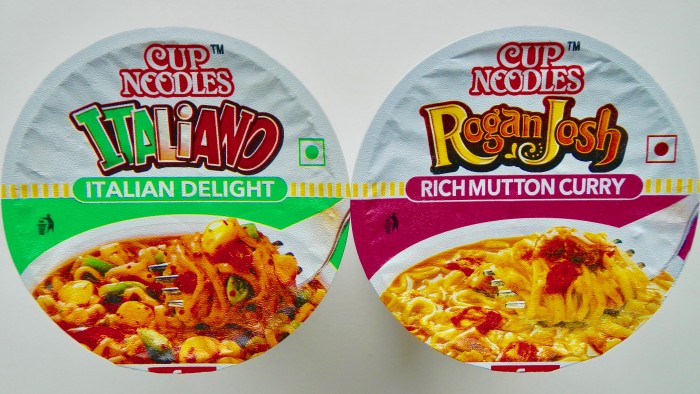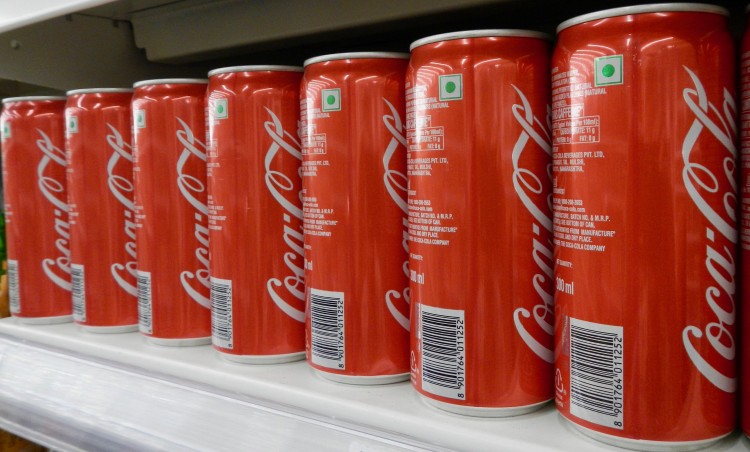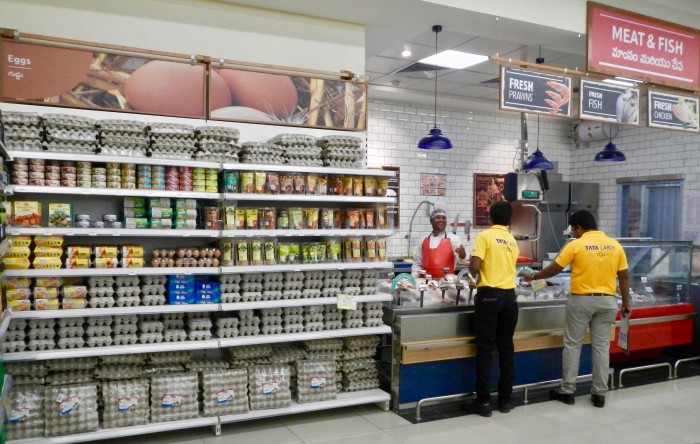Reporting from an ongoing fieldwork in Hyderabad, India, the central topic of this piece is the ways in which the vegetarian and the nonvegetarian are understood, practiced, and contested in contemporary India. I argue that “vegetarianism,” especially when seen to be inseparable from Hinduism and the caste system, can fruitfully be unpacked when explored empirically vis-à-vis the nonvegetarian. What is more, I show that context matters when exploring the vegetarian and nonvegetarian in the interfaces between state/politics, markets, and consumers in Hyderabad. My preliminary findings suggest that the relationship between the vegetarian and nonvegetarian is being redefined in contemporary India: the long-held idea that the more individuals and social groups follow a vegetarian lifestyle the higher social status they enjoy is breaking down. What is more, vegetarianism and meat-eating are increasingly individual lifestyle choices rather than determined by religious orthodoxy.
There is a large body of literature on Hindu vegetarianism, but why and how Hindus eat meat is not well understood. Much of the existing literature often assumes that not only does the concept of ahimsa (noninjury to all living creatures) prevent Hindus from eating meat, but also that the relationship between the vegetarian and nonvegetarian is relatively simple and stable among Hindu groups. However, the complex and contested relationship between the vegetarian and the nonvegetarian is as topical as ever, and in the local setting I explore this, for example, among Brahmins (Hindu priests who traditionally promote vegetarianism and cow veneration) and Dalits (untouchables who traditionally eat beef and other types of meat and consider that rightful). I also examine how markets, including hypermarkets (a combination of a supermarket and a department store), and local and transnational manufacturing companies respond to these transformations.
A key question is how Hindu consumers understand, practice, and contest vegetarianism and meat-eating in their everyday lives, and my ethnography challenges the idea that class/caste affiliation is inseparable from the vegetarian/nonvegetarian, that is, the higher the caste the less likely Hindus are to eat meat and, conversely, the lower the caste the more likely meat consumption is. This project continues my research into the relationship between religion and markets (Fischer 2008, 2011, 2015; Lever and Fischer 2017).
I am in the Star hypermarket in Gachibowli, a booming IT suburb about 20 kilometers west of Hyderabad in the state of Telangana. The Star hypermarket opened in 2017, and like in all other stores across India, all food (except vegetables and meat) (Figure 1), drinks (Figure 2), and care products (Figure 3) carry distinctive green (vegetarian/veg) or brown (nonvegetarian/non-veg) marks. In 2011, the Indian state made it mandatory that all processed food products must bear these marks to indicate whether products are vegetarian or nonvegetarian. In India, the color green can be seen to symbolize new beginnings, harvest, happiness, nature, and divinity, while brown, the color of dying leaves, can be associated with death and mourning.
Narendra Modi, India’s prime minister since 2014 from the Hindu nationalist Bharatiya Janata Party (BJP), is a strict vegetarian and promotes vegetarianism as a national project. After coming to power, Modi decreed that not only all food products but also all nutraceuticals (dietary supplements), care products, and cosmetics should also be labeled either green or brown. Local and multinational industry players, who have entered India in large numbers in the wake of market reforms and liberalization starting in the 1990s, filed a lawsuit arguing that the law was rushed through without any kind of consultation, with high costs, and with highly complex implementation.
In the Star hypermarket, as well as hypermarkets such as Spar, a wide range of fresh meat and (live) fish are readily available for consumers to buy (Figure 4)—and they certainly do so: during my fieldwork in Hyderabad and Delhi lines in front of meat sections in these hypermarkets are often long, and hypermarket managers told me that the sale of meat is booming, including among new groups of consumers who traditionally were vegetarians. In the Spar hypermarket that opened in central Hyderabad in 2007, the meat/fish section is still enclosed behind a glass wall that clearly sets it off from the main shopping area. The side of the glass wall that faces the main shopping area is lined with vegetarian products from Organic India (the country’s largest producer of organic products that are also marketed internationally). Thus, the division between the meat/fish on one side and the main shopping area on the other is clearly marked and “fortified” by “green” Organic India products that appeal to many middle-class consumers. In Gachibowli hypermarkets that recently opened, there is no wall between the meat/fish and the main shopping area, and the reason for this is twofold: first, meat and its consumption is becoming more and more accepted in India, even among Hindu groups who traditionally were vegetarians, and, second, new hypermarkets are designed to accommodate for the sale of meat/fish.
It is all there in the Indian hypermarkets: the way in which neoliberal reforms and intensified globalization of food markets has led to a vast pluralization of shopping desires and choices; religious, vegetarian/vegan, and “green” protest and regulation that struggle to keep up with but also legitimize production, trade, and consumption; and large and growing numbers of middle-class Hindu consumers who are confronted with all these vast changes on a daily basis.
Several features characterize vegetarianism and how it is studied: morality; food production; religion/spirituality; “New Order” (political critiques of the “conventional” social order); health/physiology; and aesthetics/gustation (Twigg 1979). All these aspects are relevant to the study of modern vegetarianism, which is integral to Hinduism and based on the concept of ahimsa (Simoons 1994). To Hindus, food/drink is closely related to bodily substance, health, well-being, and purity/pollution, as well as to caste, class, gender, and kinship. However, Hindu vegetarianism among divergent class and caste groups has always been contentious in India, but now the country finds itself at the interface of three major transformations that are fundamentally reshaping conventional forms of vegetarianism: Hinduization (promotion of Hinduism) of state and society; an increasing number of companies that are involved in and must comply with rising vegetarian forms of regulation; and the emergence of a new Hindu middle class of about 300 million consumers attentive to the crucial distinction between the vegetarian and nonvegetarian. All my middle-class Hindu informants could classify family, friends, and colleagues as “veg” or “non-veg.” At the same time, long-held notions of vegetarianism as superior, healthy, and spiritual are being reconceptualized, and my project unpacks these developments among South Indian Hindus who are not necessarily at the forefront of vegetarian politics, and Hindu nationalism as it is practiced in some Indian states in the north.
Paradoxically, these middle-class Hindus go about their everyday food consumption in the world’s most standardized market for vegetarian products in which green/brown marks are ubiquitous and can be found on billions of products and on the facades of restaurants. “Standardized” implies industrially produced and processed foods promised by companies to comply with standards set by the Indian state. Ironically, powerful Hindu nationalist discourses about vegetarianism are matched by the fact that over the past two decades, Indians have been producing and eating more meat (Robbins 1999), which is also the case with many of my informants. In fact, statistics show that Telangana may be the least vegetarian state in India, and this project explores why and how this may the case. Simultaneously, the global market for vegetarian (food) products has exploded within the past few years. Nowhere is this more visible than in India, which is one of the largest and fastest growing markets for processed foods in the world.
Most of the recent anthropological studies on India’s middle class explore this topic between state and market, and stress the important role consumption has come to play in the post-liberalization era starting in 1991 (Fernandes 2000; Mazzarella 2003; Osella and Osella 2000), cultural politics (Baviskar and Ray 2011), or Hinduization (Hansen 1999) of state and society. While these studies are important, there is little research on Hindu consumer cultures between state, market, and class transformation, and this project bridges the above approaches to fill this gap. Existing studies of vegetarianism in India conventionally explore Hindu disgust and fascination with traditional meat markets in the bazaar (Ghassem-Fachandi 2012) or vegetarianism in Hindu philosophy (Roy 2002). The predominant literature on vegetarianism in India and South Asia more broadly mostly explores microsocial aspects such as the everyday consumption among Hindu groups and, to a lesser extent, public vegetarianism as effects of “gastro-politics,” that is, how beliefs about food encode a complex set of social and moral propositions (Appadurai 1981). What is more, most studies explore individual and group food consumption and not surrounding markets and regulation. In both political/public discourses, as well as scholarly studies, Hindu meat-eating as is often seen as exceptional and/or generated by certain ritual or religious circumstances rather as an everyday practice. Most studies tend to assume that ahimsa ideas and practices that may be relatively stable and intact among higher caste groups in Indian states or locations such as Gujarat and Rajasthan, where vegetarianism is widespread among Hindu groups, are representative of India as a whole. Thus, most anthropological studies of vegetarianism and cow veneration, such as those of Parvis Ghassem-Fachandi (2012) for Gujarat and Lawrence Babb (2004) on Rajasthan, focus on states and contexts where vegetarianism is relatively stable among most of the population.
In powerful political discourses, there seems to be an unfortunate tendency to accept at face value that most Hindus essentially are or desire to be vegetarians, while Muslims and lower castes are not. Even if statistics in India show that most Hindus are nonvegetarians, the national myth that India is or should be a vegetarian nation is promoted and upheld. I pay specific attention to sanitized forms of vegetarianism that are not necessarily related to meat, that is, the revolution in the processed food sector, but also nonfood products such as health supplements and care products such as toothpaste that are also subjected to new forms of regulation. At the same time, meat is all-important: so-called cow lynchings are frequent in India. In most cases, Muslims are accused of mistreating or eating holy cows, which are lynched by Hindu mobs. Beef is hotly debated in Telangana, and on many occasions, Dalit groups have been attacked verbally and physically when advocating for their right to eat beef and celebrate beef at festivals.
Contrary to traditional vegetarianism, commercialized and standardized vegetarianism is on the one hand a marker of new and mobile middle-class Hindu identities and on the other hand promoted by some Hindu groups as an Indian “Hindu virtue.” Simultaneously, some ethnic, class, and caste groups consider meat prestigious and vital for nutrition and retailers are aware of this fact. Controversies over what Hinduism is, or ought to be, are intensifying as the practices of food consumption are increasingly being standardized in contemporary India. As new food consumer practices emerge, they give rise to new ways of discussing Hinduism and proper Hindu practices.
Johan Fischer is Associate Professor in the Department of Social Sciences and Business at Roskilde University in Denmark. His work focuses on modern religion and consumer culture.
References
Appadurai, Arjun. 1981. Gastro-politics in Hindu South Asia. American Ethnologist 8 (3): 494–511.
Babb, Lawrence. 2004. Alchemies of violence: Myths of identity and the life of trade in western India. New Delhi: Sage.
Baviskar, Amita, and Raka Ray. 2011. Elite and everyman: The cultural politics of the Indian middle classes. London: Routledge.
Fernandes, Leela. 2006. India’s new middle class: Democratic politics in an era of economic reforms. Minneapolis: University of Minnesota Press.
Fischer, Johan. 2011. The halal frontier: Muslim consumers in a globalized market. New York: Palgrave Macmillan.
Fischer, Johan. 2008. Proper Islamic consumption: Shopping among the Malays in modern Malaysia. Copenhagen: Nordic Institute of Asian Studies Press.
Fischer, Johan. 2015. Islam, standards and technoscience: In global halal zones. New York: Routledge.
Ghassem-Fachandi, Parvis. 2012. Pogrom in Gujarat: Hindu nationalism and anti-Muslim violence in India. Princeton, NJ: Princeton University Press.
Hansen, Thomas Blom. 1999. The saffron wave: Democracy and Hindu nationalism in modern India. Princeton, NJ: Princeton University Press.
Lever, John, and Johan Fischer. 2017. Religion, regulation, consumption: Globalising kosher and halal markets. Manchester: Manchester University Press.
Mazzarella, William. 2003. Shoveling smoke: Advertising and globalization in contemporary India. Durham, NC: Duke University Press.
Osella, Filippo, and Caroline Osella. 2000. Social mobility in Kerala: Modernity and identity in conflict. London: Pluto Press.
Robbins, Paul. 1999. Meat matters: Cultural politics along the commodity chain in India. Cultural Geographies 6 (4): 399–423.
Roy, Parama. 2002. Meat-eating, masculinity and renunciation in India: A Gandhian grammar of diet. Gender and History 14 (1): 62–91.
Simoons, Frederick J. 1994. Eat not this flesh: Food avoidances from prehistory to the present. Madison: University of Wisconsin Press.
Twigg, Julia. 1979. Food for thought: Purity and vegetarianism. Religion 9 (1): 13–35.
Cite as: Fischer, Johan. 2017. “Veg or non-veg? On fieldwork and food in India.” FocaalBlog, 24 October. www.focaalblog.com/2017/10/24/johan-fischer-veg-or-non-veg.
Discover more from FocaalBlog
Subscribe to get the latest posts sent to your email.



